![]()
![]()
![]()
Use LEFT and RIGHT arrow keys to navigate between flashcards;
Use UP and DOWN arrow keys to flip the card;
H to show hint;
A reads text to speech;
37 Cards in this Set
- Front
- Back
|
def'n: neoplasm
|
abnormal mass of tissue, growth of which exceeds and is uncoordinated with that of normal tissues, and persists in the same excessive manner after cessation of the stimulus which evoked the change.
|
|
|
Cancer:
|
Cancerrefers to collection of diseases in which abnormal cells divide uncontrollablyand demonstrate capacity to invade into other tissue (local infiltration ordistant metastasis)
|
|
|
opportunities for intervention in cancer 6
|
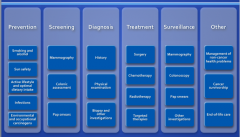
|
|
|
Things that distinguish cancer cells from normal cells 6
|
Self-sufficiency in growth signals:Cancercells produce their own growth signals and proliferate without environmentalcues
Insensitivity to anti-growthsignals:Cancercells evade anti-growth signals in order to proliferate Tissue invasion and metastasis:Tumor masses spawn pioneer cellsthat colonize sites where nutrients and space are not limiting Limitless potential for replication:Tumor cell DNA replicates aninfinite number of times Sustained angiogenesis:Cancer cells induce and sustainblood vessel growth Evade apoptosis:Tumorcells avoid programmed cell death and expand in number |
|
|
carcinoma
|
derived from eipthelial cells like colon, breast
|
|
|
Lymphomas adn leukemias
|
derived from hematopoietic cells
|
|
|
sarcomas
|
derived from mesenchymal cells (= connective tissue)
|
|
|
blastoma
|
derived from immature precursor or embryonic tissues
|
|
|
Clonality
|
Derivedfrom single progenitor cell
Cellsretain same genetic or epigenetic abnormality (mutation) |
|
|
Grade
|

|
|
|
Metaplasia
1. define 2. reversible/irreversible? |
Replacementof one normal epithelium with another (e.g.: Barrett’s esophagus)Reversibleif inciting cause removed
|
|
|
Dysplasia
1. define 2. reversible/irreversible |
Disorderedgrowth and differentiation of epithelium. Reversibleif inciting cause removed
|
|
|
recognize continuum between metaplasia, dysplasia, and invasive disease
note that multiple insults move cells further down this continuum. |
k
|
|
|
Idea of stepwise transition from metaplasia, to dysplasia, to cancer: sporadic colorectal cancer
|

|
|
|
explain significance of microsatellite instability in colorectal cancer
|

|
|
|
Locally advanced
1. define 2. surgical prognosis |
Local growth with direct invasion into adjacent structures.
surgical prognosis: not likely that surgeon will be able to resect with negative margins |
|
|
Mets: 3 routes of spread
|
1. hematogenous
2. lymphatic 3. transcoelomic dissemination = distant disease histologically equivalent to primary site |
|
|
transcoelomic dissemination
|
The spread of a malignancy into body cavities can occur via penetrating the surface of the peritoneal, pleural, pericardial, or subarachnoid spaces. For example, ovarian tumors can spread transperitoneally to the surface of the liver.
|
|
|
circumscribed vs. spiculated
|
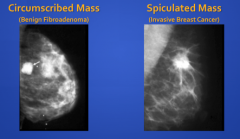
|
|
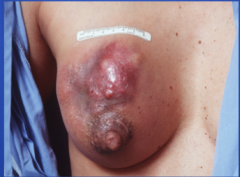
how would you describe this breast Ca
|
locally advanced
|
|
|
lower limit for cancer detection (mass size) (radiologically)
|
0.5 to 1cm diameter. PE less sensitive
|
|
|
limit of clinical detection (#cells)
lethal burden (#cells) |

detection threshold: 10^9 cells, or 1 gram
lethal threshold: 10^12 cells, or 1 kg |
|
|
role of screening:
|
tests asymptomatic people at risk of illness
|
|
|
TNM staging
|
Tumor size or depth of penetration
N: degree of LN involvement M: absence or presence of mets prognostically useful. |
|
|
review: local and systemic symptoms for various cancers
|
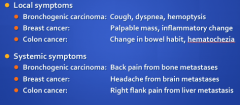
|
|
|
define: paraneoplastic syndrome
|
not attributed to direct effect of 1º or metastatic disease. represent remote effect of cancer.
hormone-mediated, cytokines, etc. improve with cancer treatment but FAIL to alter prognosis |
|
|
Paraneoplastic syndrome in SCLC
|
hyponatremia and SIADH
|
|
|
renal cell carcinoma: paraneoplastic syndrome
|
hyperCa from PTH-rp
|
|
|
define local therapy
|
for Ca confined to primary and regional LNs
tx is delivered with curative intent |
|
|
Adjuvant therapy
|
administered after surgery for early stage disease to control potential residual (microscopic) disease.
|
|
|
local adjuvant therapy?
|
eg radiotherapy
|
|
|
systemic adjuvant therapy?
|
eg antihormonal or chemotherapy (with or without targeted therapy
|
|
|
3 reasons that we give neoadjuvant therapy before primary treatment (surgery) in non-metastatic disease
|
1. reduce size of Ca
2. prevent early dissemination of cancer cells 3. reduce risk of recurrence and improve long-term survival |
|
|
Tx with Palliative intent: 3 aspects
|
Maintainor improve quality of life
Reduceextent of disease (relieve symptoms or delay complications) Prolonglife, if possible but without chance of cure |
|
|
Examples of local palliative treatment
|
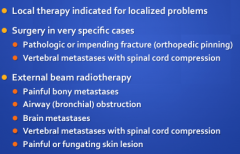
|
|
|
quick glance: management of metastatic disease and an incurable situation
|

|
|
|
summary: cancer produces symptoms through: 3 main categories
|
1. local growth
2. distant growth 3. paraneoplastic phenomena |

